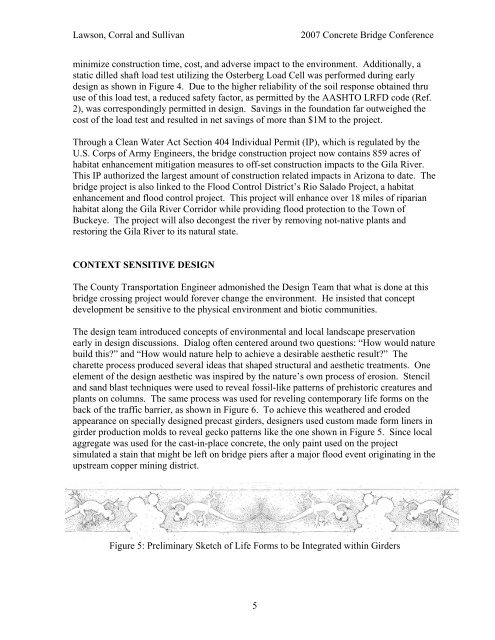ASPIRE Spring 09 - Aspire - The Concrete Bridge Magazine
ASPIRE Spring 09 - Aspire - The Concrete Bridge Magazine
ASPIRE Spring 09 - Aspire - The Concrete Bridge Magazine
You also want an ePaper? Increase the reach of your titles
YUMPU automatically turns print PDFs into web optimized ePapers that Google loves.
Lawson, Corral and Sullivan<br />
2007 <strong>Concrete</strong> <strong>Bridge</strong> Conference<br />
minimize construction time, cost, and adverse impact to the environment. Additionally, a<br />
static dilled shaft load test utilizing the Osterberg Load Cell was performed during early<br />
design as shown in Figure 4. Due to the higher reliability of the soil response obtained thru<br />
use of this load test, a reduced safety factor, as permitted by the AASHTO LRFD code (Ref.<br />
2), was correspondingly permitted in design. Savings in the foundation far outweighed the<br />
cost of the load test and resulted in net savings of more than $1M to the project.<br />
Through a Clean Water Act Section 404 Individual Permit (IP), which is regulated by the<br />
U.S. Corps of Army Engineers, the bridge construction project now contains 859 acres of<br />
habitat enhancement mitigation measures to off-set construction impacts to the Gila River.<br />
This IP authorized the largest amount of construction related impacts in Arizona to date. <strong>The</strong><br />
bridge project is also linked to the Flood Control District’s Rio Salado Project, a habitat<br />
enhancement and flood control project. This project will enhance over 18 miles of riparian<br />
habitat along the Gila River Corridor while providing flood protection to the Town of<br />
Buckeye. <strong>The</strong> project will also decongest the river by removing not-native plants and<br />
restoring the Gila River to its natural state.<br />
CONTEXT SENSITIVE DESIGN<br />
<strong>The</strong> County Transportation Engineer admonished the Design Team that what is done at this<br />
bridge crossing project would forever change the environment. He insisted that concept<br />
development be sensitive to the physical environment and biotic communities.<br />
<strong>The</strong> design team introduced concepts of environmental and local landscape preservation<br />
early in design discussions. Dialog often centered around two questions: “How would nature<br />
build this?” and “How would nature help to achieve a desirable aesthetic result?” <strong>The</strong><br />
charette process produced several ideas that shaped structural and aesthetic treatments. One<br />
element of the design aesthetic was inspired by the nature’s own process of erosion. Stencil<br />
and sand blast techniques were used to reveal fossil-like patterns of prehistoric creatures and<br />
plants on columns. <strong>The</strong> same process was used for reveling contemporary life forms on the<br />
back of the traffic barrier, as shown in Figure 6. To achieve this weathered and eroded<br />
appearance on specially designed precast girders, designers used custom made form liners in<br />
girder production molds to reveal gecko patterns like the one shown in Figure 5. Since local<br />
aggregate was used for the cast-in-place concrete, the only paint used on the project<br />
simulated a stain that might be left on bridge piers after a major flood event originating in the<br />
upstream copper mining district.<br />
Figure 5: Preliminary Sketch of Life Forms to be Integrated within Girders<br />
5

















